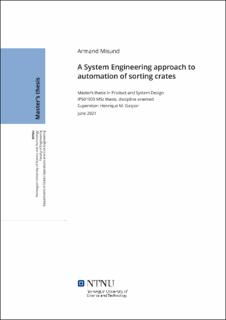| dc.contributor.advisor | Gaspar, Henrique M. | |
| dc.contributor.author | Misund, Armand | |
| dc.date.accessioned | 2022-02-01T18:21:20Z | |
| dc.date.available | 2022-02-01T18:21:20Z | |
| dc.date.issued | 2021 | |
| dc.identifier | no.ntnu:inspera:87649307:24544552 | |
| dc.identifier.uri | https://hdl.handle.net/11250/2976427 | |
| dc.description.abstract | Automatisere en manuell prosess er en åpen oppgave med mange innfallsvinkler og løsninger å velge mellom. Ved å bruke et verktøy som Systems Engineering for å kartlegge prosessen og et utvalg av løsninger, er det mulig å sammenligne flere forhåndsdefinerte KPI-verdier.
Utgangspunktet for denne oppgaven var en manuell sorteringsprosess som skulle automatiseres av Currence Robotics. Prosessen innebar kvalitetskontroll og sortering etter størrelse og kvalitet på to forskjellige plastkasser, IFCO 6420 og 4314.
Currence Robotics har allerede laget en automatisk løsning for sortering av paller kalt “Sort” og ønsket at denne teknologien skulle vurderes for sortering av kasser. For å samle inn informasjon om den manuelle prosessen ble det foretatt foretaksbesøk der prosessen ble observert, og tiden for ulike delprosesser som ble identifisert ble målt. Intervjuer ble også gjennomført med operatørene som utførte prosessen, og ingeniører fra Currence Robotics. På samme måte ble den automatiske sorteringsmaskinen "Sort" observert i drift for å kartlegge atferd og strukturelle elementer. Sammen med intervjuer med ingeniørene bak maskinen, dannet dette grunnlaget for kartleggingen av tilgjengelig teknologi hos klienten.
I tillegg til dette ble det laget en litteraturgjennomgang av automatiske sorteringsprosesser fra ulike bransjer, med fokus på prosessen og tekniske løsninger.
Med litteraturgjennomgangen av Systems Engineering ble det laget en metode for å kartlegge den manuelle prosessen og ulike løsningsforslag basert på et sett med KPI-er.
Løsningsforslagene, kalt endringssaker, var basert på den manuelle prosessen og en økende grad av automatiske løsninger ble implementert. I endringssak 3 er sorteringsprosessen fullstendig automatisert med teknologi fra Currence Robotics.
I samarbeid med Currence Robotics ble et sett med KPI definert og brukt i vurderingen av alle saker, inkludert den manuelle. Dette er Opex [NOK], Capex [NOK], Pålitelighet [Stopper over tid], Robusthet [%, Sannsynlighet for konsekvens] og Effektivitet [kasser pr. time].
Tiden det tok å sortere et gitt antall kasser avtok med økende implementering av automatisering gjennom de forskjellige endringssakene. Med redusert tidsforbruk økte effektiviteten og antall kasser per time, fra 300 i manuell sak, til 1200 i helautomatisert tilfelle, endre tilfelle 3.
Økningen i automatisering resulterte også i økte kostnader, både kapital- og driftskostnader. Ser vi på kostnadsøkningen i forhold til kapasitetsøkningen, reduseres kostnaden per sortert kasse med omtrent 50%.
Den manuelle prosessen sorterer 300 kasser i timen, og hvis vi ser på kostnaden per sortert kasse, må den helautomatiske saken kasse 600 kasser i timen for å ha samme kostnad som manualen per kasse. Det interessante er at den helautomatiske saken har en kapasitet på 1200 kasser i timen og er lønnsom allerede etter 600 kasser i timen sammenlignet med dagens manuelle løsning. | |
| dc.description.abstract | Automating a manual process is an open task with many angles of incidence and solutions to choose from. By using a tool such as Systems Engineering to map the process and a selection of solutions, it is possible to compare several predefined KPI values.
The starting point for this thesis was a manual sorting process that was to be automated by Currence Robotics. The process involved quality check and sorting by size and quality of two different plastic crates, the IFCO 6420 and 4314.
Currence Robotics has already created an automatic solution for sorting pallets named “Sort” and wanted this technology to be considered for the sorting of crates. To gather information about the manual process, company visits were made where the process was observed, and the time of various sub-processes that were identified was measured. Interviews were also conducted with the operators performing the process, and engineers from Currence Robotics. In the same way, the automatic sorting machine "Sort" was observed in operation to map behaviour and structural elements. Together with interviews with the engineers behind the machine, this formed the basis for the mapping of available technology at the client.
In addition to this, a literature review was made of automatic sorting processes from various industries, with focus on the process and technical solutions.
With the literature review of Systems Engineering, a method was created to map the manual process and various solution proposals based on a set of KPIs.
The solution proposals, called change cases, were based on the manual process and an increasing degree of automatic solutions were implemented. In change case 3, the sorting process is completely automated with technology from Currence Robotics.
In collaboration with Currence Robotics, a set of KPIs was defined and used in the assessment of all cases, including the manual one. These are Opex [NOK], Capex [NOK], Reliability [Stops over time], Robustness [%, Probability of consequence], and Efficiency [crates per. hour].
The time it took to sort a given number of crates decreased with increasing implementation of automation through the various change cases. With reduced time consumption the efficiency and number of crates per hour increased, from 300 in the manual case, to 1200 in the fully automated case, change case 3.
The increase in automation also resulted in increased costs, both capital- and operating costs. If we look at the cost increase in relation to the capacity increase, the cost per sorted crate decreases by about 50%.
The manual process sorts 300 crates per hour, and if we look at the cost per sorted crate, the fully automated case must sort 600 crates per hour to have the same cost as the manual per crate. The interesting thing is that the fully automated case has a capacity of 1200 crates per hour and is profitable already after 600 crates per hour compared to today's manual solution. | |
| dc.language | eng | |
| dc.publisher | NTNU | |
| dc.title | A System Engineering approach to automation of sorting crates | |
| dc.type | Master thesis | |
